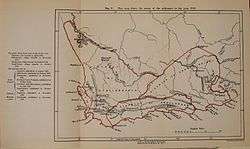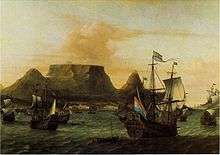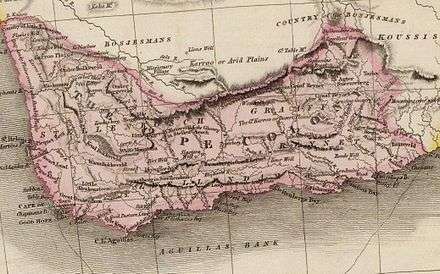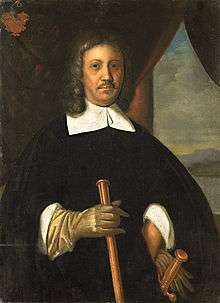Dutch Cape Colony
The Cape Colony (Dutch: Kaapkolonie) was a Dutch East India Company colony in Southern Africa, centered on the Cape of Good Hope, whence it derived its name. The original colony and its successive states that the colony was incorporated into occupied much of modern South Africa. Between 1652 and 1691 a Commandment, and between 1691 and 1795 a Governorate of the Dutch East India Company. Jan van Riebeeck established the colony as a re-supply and layover port for vessels of the Dutch East India Company trading with Asia.[2] The Cape came under Dutch rule from 1652 to 1795 and again from 1803 to 1806.[3] Much to the dismay of the shareholders of the Dutch East India Company, who focused primarily on making profits from the Asian trade, the colony rapidly expanded into a settler colony in the years after its founding.
Cape Colony Kaapkolonie | |||||||
|---|---|---|---|---|---|---|---|
| 1652–1806 | |||||||
 Flag
 Coat of arms
| |||||||
 Dutch Cape Colony at it's largest extent in 1795. | |||||||
| Status | Dutch Colony under Company rule (1652–1797) British Occupation (1797–1803) Batavian Republic (1803–1806) | ||||||
| Capital | First the Castle of Good Hope, then Kaapstad | ||||||
| Common languages | Dutch (official) Afrikaans Xiri Korana Khoekhoe isiXhosa | ||||||
| Religion | Dutch Reformed native beliefs | ||||||
| Governor | |||||||
• 1652–1662 | Jan van Riebeeck | ||||||
• 1662 - 1666 | Zacharias Wagenaer | ||||||
• 1771–1785 | Joachim van Plettenberg | ||||||
• 1803–1806 | Jan Willem Janssens | ||||||
| Historical era | Imperialism | ||||||
| 6 April 1652 | |||||||
• Elevated to Governorate | 1691 | ||||||
• First British occupation | 7 August 1795 | ||||||
• Cape Colony restored to Dutch rule | 1 March 1803 | ||||||
| 8 January 1806 | |||||||
| Area | |||||||
| 1795 | 145,000 km2 (56,000 sq mi) | ||||||
| Population | |||||||
• 1650 | 1,500 | ||||||
• 1797 | 61,947[1] | ||||||
• 1800 | 18,000 | ||||||
| Currency | Dutch rijksdaalder | ||||||
| |||||||
| Today part of | |||||||
| Historical states in present-day South Africa |
|---|
 |
|
before 1600
|
|
1600–1700
|
|
1700–1800
|
|
1800–1850
|
|
1850–1875
|
|
1875–1900
|
|
1900–present
|
|
|
As the only permanent settlement of the Dutch East India Company not serving as a trading post, it proved an ideal retirement place for employees of the company. After several years of service in the company, an employee could lease a piece of land in the colony as een Vryburgher ("a free citizen"), on which he had to cultivate crops that he had to sell to the Dutch East India Company for a fixed price. As these farms were labour-intensive, Vryburghers imported slaves from Madagascar, Mozambique and Asia ( Dutch East Indies and Dutch Ceylon ), which rapidly increased the number of inhabitants.[2] After King Louis XIV of France revoked the Edict of Nantes (October 1685), which had protected the right of Huguenots in France to practise Protestant worship without persecution from the state, the colony attracted many Huguenot settlers, who eventually mixed with the general Vryburgher population.
Due to the authoritarian rule of the Company (telling farmers what to grow for what price, controlling immigration, and monopolising trade), some farmers tried to escape the rule of the company by moving further inland. The Company, in an effort to control these migrants, established a magistracy at Swellendam in 1745 and another at Graaff Reinet in 1786, and declared the Gamtoos River as the eastern frontier of the colony, only to see the Trekboere cross it soon afterwards. In order to avoid collision with the Bantu peoples advancing south, north and west from east central Africa, the Dutch agreed in 1780 to make the Great Fish River the boundary of the colony.
In 1795, after the Battle of Muizenberg in present-day Cape Town, the British occupied the colony. Under the terms of the Peace of Amiens of 1802, Britain returned the colony to the Dutch on 1 March 1803, but as the Batavian Republic had since nationalized the Dutch East India Company (1796), the colony came under the direct rule of The Hague. Renewed Dutch control did not last long, however, as the outbreak of the Napoleonic Wars (18 May 1803) invalidated the Peace of Amiens. In January 1806, the British occupied the colony for a second time after the Battle of Blaauwberg at present-day Bloubergstrand. The Anglo-Dutch Treaty of 1814 confirmed the transfer of sovereignty to Great Britain. However most of the Dutch settlers remained in the colony under new leadership of the British.
History
Dutch East India Company




Traders of the Dutch East India Company (VOC), under the command of Jan van Riebeeck, were the first people to establish a European colony in South Africa. The Cape settlement was built by them in 1652 as a re-supply point and way-station for Dutch East India Company vessels on their way back and forth between the Netherlands and Batavia (Jakarta) in the Dutch East Indies. The support station gradually became a settler community, the forebears of the Boers, an ethnic group in South Africa also known as the Afrikaners.
Khoisan of the Cape
At the time of first European settlement in the Cape, the southwest of Africa was inhabited by San people and Khoikhoi who were pastoral people with a population estimated between 13,000 and 15,000.[4] The Khoisan nomadic people were disgruntled by the disruption of their seasonal visit to the area for which purpose they grazed their cattle at the foot of Table Mountain only to find European settlers occupying and farming the land, leading to the 1st Khoi-Dutch War as part of a series of Khoikhoi-Dutch Wars. After the war, the natives ceded the land to the settlers in 1660. During a visit in 1672, the high-ranking Commissioner Arnout van Overbeke made a formal purchase of the Cape territory, although already ceded in 1660, his reason was to "prevent future disputes".[5]
The ability of the European settlers to produce food at the Cape initiated the decline of the nomadic lifestyle of the Khoisan since food was produced at a fixed location. Thus by 1672 the permanent Khoisan residents living at the Cape had grown substantially. The first school to be build in South Africa by the settlers were for the sake of the slaves who had been rescued from a Portuguese slaveship and arrived at the Cape with the Amersfoort in 1658. Later on, the school was also attended by the children of the Khoisan and the Free Burghers. The Dutch language was taught at schools as the main medium for commercial purposes, with the result that the Khoisan and even the French settlers found themselves speaking Dutch more than their native languages. The principles of Christianity were also introduced at the school resulting in the baptisms of many slaves and Khoisan residents.[5]
Conflicts with the settlers and the effects of smallpox decimated their numbers in 1713 and 1755, until gradually the breakdown of their tribal society led them to work for the colonists, mostly as shepherds and herdsmen.[4]
Free Burghers
The VOC favoured the idea of freemen at the Cape and many settlers requested to be discharged in order to become free burghers, as a result Jan van Riebeeck approved the notion on favorable conditions and earmarked two areas near the Liesbeek River for farming purposes in 1657. The two areas which were allocated to the freemen, for agricultural purposes, were named 'Groeneveld' and 'Dutch Garden'. These areas were separated by the Amstel River (Liesbeek River). Nine of the best applicants were selected to use the land for agricultural purposes. The freemen or free burghers as they were afterwards termed, thus became subjects, and were no longer servants, of the Company.[6]
Trekboere
After the first settlers spread out around the Company station, nomadic European livestock farmers, or Trekboeren, moved more widely afield, leaving the richer, but limited, farming lands of the coast for the drier interior tableland. There they contested still wider groups of Khoikhoi cattle herders for the best grazing lands. By 1700, the traditional Khoikhoi lifestyle of pastoralism had disappeared.
The Cape society in this period was thus a diverse one. The emergence of Afrikaans, a new vernacular language of the colonials that is however intelligible with Dutch, shows that the Dutch East India Company immigrants themselves were also subject to acculturation processes. By the time of British rule after 1795, the sociopolitical foundations were firmly laid.
The British Conquest

In 1795, France occupied the Seven Provinces of the Netherlands, the mother country of the Dutch East India Company. This prompted Great Britain to occupy the territory in 1795 as a way to better control the seas in order to stop any potential French attempt to get to India. The British sent a fleet of nine warships which anchored at Simon's Town and, following the defeat of the Dutch militia at the Battle of Muizenberg, took control of the territory. The Dutch East India Company transferred its territories and claims to the Batavian Republic (the Revolutionary period Dutch state) in 1798, and ceased to exist in 1799. Improving relations between Britain and Napoleonic France, and its vassal state the Batavian Republic, led the British to hand the Cape Colony over to the Batavian Republic in 1803 (under the terms of the Treaty of Amiens).
In 1806, the Cape, now nominally controlled by the Batavian Republic, was occupied again by the British after their victory in the Battle of Blaauwberg. The temporary peace between Britain and Napoleonic France had crumbled into open hostilities, whilst Napoleon had been strengthening his influence on the Batavian Republic (which he would subsequently abolish later the same year). The British, who set up a colony on 8 January 1806, hoped to keep Napoleon out of the Cape, and to control the Far East trade routes. In 1814 the Dutch government formally ceded sovereignty over the Cape to the British, under the terms of the Convention of London.
Administrative divisions

The Dutch Cape Colony was divided into four districts:[7]
| District | 1797 population |
|---|---|
| District of the Cape | 18,152 |
| District of Stellenbosch and Drakenstein | 22,959 |
| District of Zwellendam | 6,663 |
| District of Graaff Reynet | 14,173 |
Commanders and governors of the Cape Colony (1652–1806)
The title of the founder of the Cape Colony, Jan van Riebeeck, was installed as "Commander of the Cape", a position he held from 1652 to 1662. During the tenure of Simon van der Stel, the colony was elevated to the rank of a governorate, hence he was promoted to the position of "Governor of the Cape".

| Name | Period | Title |
|---|---|---|
| Jan van Riebeeck | 7 April 1652 – 6 May 1662 | Commander |
| Zacharias Wagenaer | 6 May 1662 – 27 September 1666 | Commander |
| Cornelis van Quaelberg | 27 September 1666 – 18 June 1668 | Commander |
| Jacob Borghorst | 18 June 1668 – 25 March 1670 | Commander |
| Pieter Hackius | 25 March 1670 – 30 November 1671 | Commander and Governor |
| 1671 - 1672 | Acting Council | |
| Albert van Breugel | April 1672 – 2 October 1672 | Acting Commander |
| Isbrand Goske | 2 October 1672 – 14 March 1676 | Governor |
| Johan Bax van Herenthals | 14 March 1676 – 29 June 1678 | Commander |
| Hendrik Crudop | 29 June 1678 – 12 October 1679 | Acting Commander |
| Simon van der Stel | 10 December 1679 – 1 June 1691 | Commander, after 1691 Governor |
| Name | Period | Title |
|---|---|---|
| Simon van der Stel | 1 June 1691 – 2 November 1699 | Governor |
| Willem Adriaan van der Stel | 2 November 1699 – 3 June 1707 | Governor |
| Johannes Cornelis d’Ableing | 3 June 1707 – 1 February 1708 | Acting Governor |
| Louis van Assenburgh | 1 February 1708 – 27 December 1711 | Governor |
| Willem Helot (acting) | 27 December 1711 – 28 March 1714 | Acting Governor |
| Maurits Pasques de Chavonnes | 28 March 1714 – 8 September 1724 | Governor |
| Jan de la Fontaine (acting) | 8 September 1724 – 25 February 1727 | Acting Governor |
| Pieter Gysbert Noodt | 25 February 1727 – 23 April 1729 | Governor |
| Jan de la Fontaine | 23 April 1729 – 8 March 1737 | Acting Governor |
| Jan de la Fontaine | 8 March 1737 – 31 August 1737 | Governor |
| Adriaan van Kervel | 31 August 1737 – 19 September 1737 (died after three weeks in office) | Governor |
| Daniël van den Henghel | 19 September 1737 – 14 April 1739 | Acting Governor |
| Hendrik Swellengrebel | 14 April 1739 – 27 February 1751 | Governor |
| Ryk Tulbagh | 27 February 1751 – 11 August 1771 | Governor |
| Baron Joachim van Plettenberg | 12 August 1771 – 18 May 1774 | Acting Governor |
| Baron Pieter van Reede van Oudtshoorn | 1772 – 23 January 1773 (died at sea on his way to the Cape) | Governor designate |
| Baron Joachim van Plettenberg | 18 May 1774 – 14 February 1785 | Governor |
| Cornelis Jacob van de Graaff | 14 February 1785 – 24 June 1791 | Governor |
| Johannes Izaac Rhenius (Isaac Reinus ) | 24 June 1791 – 3 July 1792 | Acting Governor |
| Sebastiaan Cornelis Nederburgh and Simon Hendrik Frijkenius | 3 July 1792 – 2 September 1793 | Commissioners-General |
| Abraham Josias Sluysken | 2 September 1793 – 16 September 1795 | Commissioner-General |
| Name | Period | Title |
|---|---|---|
| George Macartney, 1st Earl Macartney | 1797–1798 | Governor |
| Francis Dundas (1st time) | 1798–1799 | Acting Governor |
| Sir George Yonge | 1799–1801 | Governor |
| Francis Dundas (2nd time) | 1801–1803 | Governor |
| Name | Period | Title |
|---|---|---|
| Jacob Abraham Uitenhage de Mist | 1803–1804 | Governor |
| Jan Willem Janssens | 1804–1807 | Governor |
References
- Robert Montgomery Martin (1836). The British Colonial Library: In 12 volumes. Mortimer. p. 112.
- "Kaap de Goede Hoop". De VOC site. Retrieved 8 February 2013.
- J. A. Heese, Den Herkoms van de Afrikaner 1657 - 1867. A. A. Balkema, Kaapstad, 1971. CD Colin Pretorius 2013. ISBN 978-1-920429-13-3. Bladsy 15.
- Newmark, S. Daniel. The South African Frontier: Economic Influences 1652-1836. Stanford University Press. pp. 10–11. ISBN 978-0-8047-1617-8.
- History of South Africa, 1484 - 1691, G.M. Theal, London 1888
- Precis of the Archives of the Cape of Good Hope, January 1652 - December 1658, Riebeeck's Journal, H.C.V. Leibrandt, P47 - 48
- Sir John Barrow (1806). Travels Into the Interior of Southern Africa. T. Cadell and W. Davies. p. 25.
Sources
| Wikimedia Commons has media related to Cape Colony. |
- The Migrant Farmer in the History of the Cape Colony. P.J. Van Der Merwe, Roger B. Beck. Ohio University Press. 1 January 1995. 333 pages. ISBN 0-8214-1090-3.
- History of the Boers in South Africa; Or, the Wanderings and Wars of the Emigrant Farmers from Their Leaving the Cape Colony to the Acknowledgment of Their Independence by Great Britain. George McCall Theal. Greenwood Press. 28 February 1970. 392 pages. ISBN 0-8371-1661-9.
- Status and Respectability in the Cape Colony, 1750–1870 : A Tragedy of Manners. Robert Ross, David Anderson. Cambridge University Press. 1 July 1999. 220 pages. ISBN 0-521-62122-4.